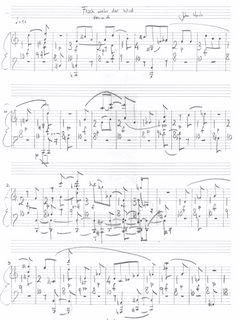
As promised in the last post, I've uploaded a graphic of the first page of Version A of Frisch weht der Wind (score is copyright John Hails 2006). This is the version of the piece that I was planning to write when I first started work on it. The dynamics, phrasing and articulation are all derived systematically from the original Satie. There are some illogical (possibly impossible) situations (see bb. 21-7 for example) that I resolve in the Versions B-D but not here. The phrasing is also slightly strange at times, but I wanted performers to solve some of the problems for themselves. The score is an 'ideal' image for the performer to aim at.
I think that it's going to be this version that I'm giving to P. I'll have to show him this page and find out if he screams.
Just to show that I have at least a semblance of a life, I went to a concert last week in Durham. Kate Ryder and David Appleton played Karlheinz Stockhausen's Mantra with electronics provided by Michael Young. It was nice to hear the piece live (last time (actually the first time) I heard it was at the Huddersfield Festival in 1996 with crazy Karlheinz in the audience) but I had niggles.
It was too slow in places (especially in the penultimate section) and it didn't sound like I remembered it. There seemed to be some pitches missing. Talked to M about this and she thought that maybe it was the bass frequencies... Perhaps a low-pass filter? Anyway, the electronics (sine tone generators) should be controlled by the pianists, not by a guy with a laptop! Anything else is a monkeying-around with the performer interface designed by the composer. The morse code section made me wonder if Michael Young had ever actually heard morse code before. A lot of the electronics was periodic and seemed to be based on quite short loops, which seems to go against the intuitive movements that Stockhausen requests in the score...
The experience made me want to maybe look into producing a Max/MSP patch for the piece, or at least to write about the issues involved (in the same way that I haven't quite got round to with Ferneyhough's Time and Motion Study no 2). Who knows? Maybe I'll have some time on my hands at some point.
All in all it was nice to hear it (and quite fun to see David Appleton in his leather trousers) but this wasn't what I'd call a representative performance, now if I could only get hold of my recording that I lent to Max...
I think that it's going to be this version that I'm giving to P. I'll have to show him this page and find out if he screams.
Just to show that I have at least a semblance of a life, I went to a concert last week in Durham. Kate Ryder and David Appleton played Karlheinz Stockhausen's Mantra with electronics provided by Michael Young. It was nice to hear the piece live (last time (actually the first time) I heard it was at the Huddersfield Festival in 1996 with crazy Karlheinz in the audience) but I had niggles.
It was too slow in places (especially in the penultimate section) and it didn't sound like I remembered it. There seemed to be some pitches missing. Talked to M about this and she thought that maybe it was the bass frequencies... Perhaps a low-pass filter? Anyway, the electronics (sine tone generators) should be controlled by the pianists, not by a guy with a laptop! Anything else is a monkeying-around with the performer interface designed by the composer. The morse code section made me wonder if Michael Young had ever actually heard morse code before. A lot of the electronics was periodic and seemed to be based on quite short loops, which seems to go against the intuitive movements that Stockhausen requests in the score...
The experience made me want to maybe look into producing a Max/MSP patch for the piece, or at least to write about the issues involved (in the same way that I haven't quite got round to with Ferneyhough's Time and Motion Study no 2). Who knows? Maybe I'll have some time on my hands at some point.
All in all it was nice to hear it (and quite fun to see David Appleton in his leather trousers) but this wasn't what I'd call a representative performance, now if I could only get hold of my recording that I lent to Max...

0 Comments:
Post a Comment
<< Home